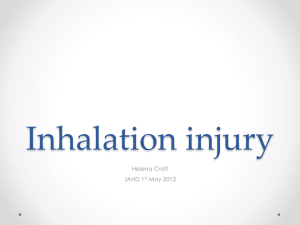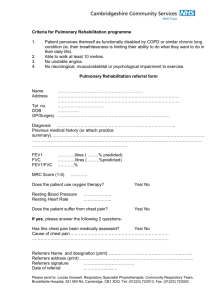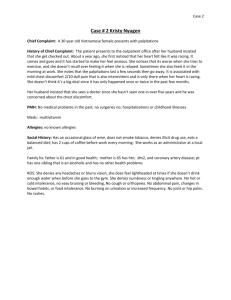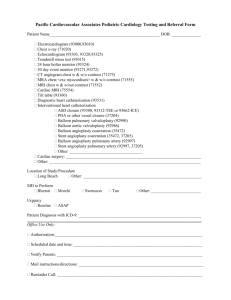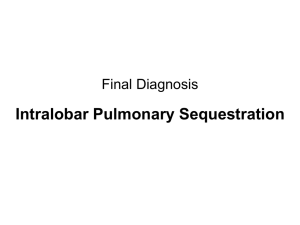Mediastinitis - Dayton Children's Hospital
advertisement
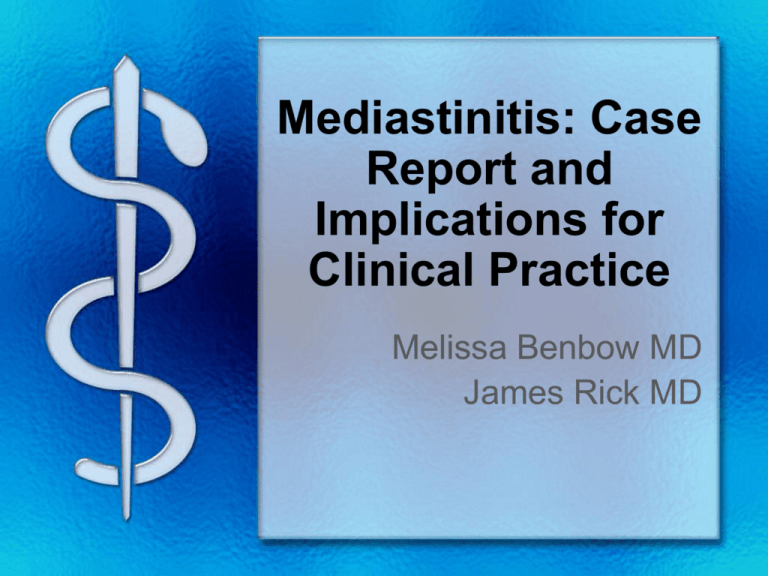
Mediastinitis: Case Report and Implications for Clinical Practice Melissa Benbow MD James Rick MD What’s the cause of mediastinitis? • Hint… • “It ain’t no black swan, just a goose on the loose.” HPI • 8yo F with 1 month of chest pain. Seen by PCP at onset and had normal exam at that time. • 2wk prior to admission developed fevers to 103, seen at CMC and admitted for O2 sats in low 90s and fevers, concern for recurrent pericarditis although normal echo and CXR normal except increased peribronchial markings. Discharged home next day. • 1wk prior to admission having persistent fevers and chest pain, + flu at PCP so referred to CMC for repeat flu testing during H1N1 outbreak. • Flu negative at CMC, but continued amantidine and tamiflu as rx by PCP. • Also started on zithromax for concern at OSH of pneumonia. HPI (continued) • Day of admission was riding bike, became pale • Still c/o substernal chest pain • Won’t lay flat because of difficulty breathing • Fevers down since starting zithromax 99-101 ROS • Gen: fever, increased fatigue • HEENT: no significant HA but occasional mild HA, otherwise negative • CV: chest pain • Resp: orthopnea • GI: no N/V/D/C. Occasional c/o mild abdominal pain since previous admission • Neuro: no numbness/tingling. No MS changes • MS: occasional c/o knee and ankle pain but no edema/erythema PMH • Pneumonia with parapneumonic effusions and pericarditis 9/2008 (~8mo prior) • Was in PICU with pericardial drain and chest tube • Thought everything secondary to pneumonia at that time although no organism identified • Had rheumatologic w/u that was negative History • Birth History: – 38wk c/s secondary to breech presentation. Home with mom in 3 days. No complications • Past Hospitalizations: – 9-10/2008 for pneumonia, pleural effusion, pericarditis, in PICU – Had been healthy prior to that • Past Surgeries: – PE tubes, pericardial drain, chest tube History • Family History: – mom with psoriasis – cousin with JIA – MGM with ovarian and breast cancer • Social History: – lives with mom, 2 half-sisters – + smoke exposure – No recent travel – No pets – Father h/o incarceration Physical Exam • VS: T 38.5, HR 96, RR 28, O2 100% RA, BP 99/61 • Gen: NAD, initially sleeping but arousable and then alert and cooperative • HEENT: NCAT, TMs clear b/l, OP clear without exudate/erythema • CV: RRR, no m/r/g, 2+ pulses • Resp: CTAB, no retractions or increased WOB, no egophony, percussion = b/l • GI: soft/NT/ND, no HSM/mass, + BS • MS: FROM x4 • Neuro: CN 2-12 intact • Skin: warm, dry, no petechiae Initial Labs • CBC • CMP • 24.4 11.6 35.3 138 97 4.5 508 8 28.7 0.4 74S, 19L, 7M 84 9.8 • Alb 3.2, AP 216, Tbili 0.4, AST 13, ALT 24, Tprot 8 • ESR 60 • Ferritin 163 • Blood culture pending Imaging, etc • CXR… • Echo: normal • EKG: normal CXR • Cystic lesion with air-fluid levels, possibly representing pneumatoceles, in the medial right lower lobe and possibly medial left lower lobe. Follow-up is suggested. Pneumatocele • Air-filled cysts within lung parenchyma • Usually secondary to pneumonia – Staph – Strep pneumo – H. influenzae • Can be secondary to trauma CT CT CT CT CT CT CT Chest CT • The air collection seen on the plain films is seen as irregular shaped air collection in the mediastinum just inferior to the carina. This is not associated with enhancing mass or fluid collection to suggest tumor or abscess. This does not appear to communicate with the pericardium or the esophagus. Esophagram should be considered as an initial evaluation to explain the air collection. • There is one tiny vessel which seen on the inferior most portion of the scan which extends from the celiac axis to the top of the liver capsule. A branch does appear to extend into a tiny area of consolidation in the right lung base and is suspicious for sequestration. • Of note, it was initially read as normal until further discussion/review of CT and then findings noted above. Pulmonary sequestration • Congenital malformation • Lung tissue that lacks normal connection with tracheobronchial tree, therefore is non-fuctioning • Receives arterial blood supply from systemic circulation • 0.15-6.4% of congenital pulmonary malformations Pulmonary sequestration • 3 types – Intra-lobar: 75-90% of sequestrations – Extra-lobar – Bronchopulmonary-foregut malformation Pulmonary sequestration • Intra-lobar – Located within a normal lobe – Lacks its own visceral pleura – Usually no bronchial connection; if so, it’s abnormal – Usually presents in adolescence with recurrent infection Pulmonary sequestration • Extra-lobar – Located outside a normal lobe – Has own visceral pleura – May present as subdiaphragmatic or retroperitoneal mass – Usually left-sided – Presents in infancy with respiratory compromise Pulmonary sequestration • Bronchopulmonary foregut malformation – Lung tissue connected to GI tract – Can be either intra- or extra-lobar – More common on right side Case—Pulm and ID consulted • Differential – Esophageal/bronchial fistula – Fistula from previous drains (pleural/pericardial) – Pulmonary sequestration--less likely – Mediastinitis: fibrosing vs postinfectious – Wegener’s – Sarcoidosis – Malignancy The arthrogram demonstrates smooth extrinsic compression on the distal esophagus in the area of concern. There is no evidence of connection between the air pocket seen on the chest x-ray and the esophagus. The patient was imaged in a right lateral decubitus and a prone position. **************************** Impression: There is smooth extrinsic compression on the distal esophagus but no evidence of a fistula to the air pocket. Mediastinitis • Post-op • Esophageal or tracheal rupture/tear – Trauma – Bronch/EGD – Foreign body • Oropharyngeal infection (descending necrotizing mediastinitis) • TB • Fibrosing mediastinitis • Spontaneous Fibrosing Mediastinitis • Histoplasma capsulatum • Ohio and Mississippi Rivers • Also endemic to areas of the Caribbean and Central and South America • Transmission: – Soil contaminated with bird droppings – Bat guano 3 Forms of Histoplasmosis 1. Acute pulmonary infection – Initial exposure to spores – Most are asymptomatic – Children and elderly more likely symptomatic • Weight loss, fever, fatigue, dyspnea • 10% have sarcoid-like illness with arthritis/arthralgia, pericarditis, keratoconjunctivitis, erythema nodosum • Children often normal CXR but can have hilar adenopathy, patchy pneumonia – Complications include mediastinal granulomas and histoplasmomas • Histoplasmomas: usually asymptomatic, usually single lesion, calcified, parenchymal origin Acute Pulmonary Infection – Mediastinal granulomas: coalescence of hilar nodes • Can compress mediastinal structures: esophagus, trachea/bronchi, vena cava • Dysphagia, cough, wheeze, hemoptysis, dyspnea, chest pain • Mediastinal fibrosis (fibrosing mediastinitis): uncontrolled fibrotic reaction • SVC syndrome, pulmonary venous obstruction, pulmonary artery obstruction with CHF – SVC syndrome: dyspnea (63%), cough, chest pain, orthopnea, dysphagia, HA, venous distention of neck, facial edema, upper extremity edema, plethora, cyanosis, papilledema, MS changes 3 Forms of Histoplasmosis 2. Chronic pulmonary histoplasmosis – Opportunistic infection in adults with emphysema, rare in children 3. Progressive disseminated histoplasmosis – Affects children and immuno-compromised – Fever, hepatosplenomegaly, thrombocytopenia, anemia, pneumonia – Extrapulmonary infection: bony lesions, oropharyngeal ulcers, chorioretinitis, endocarditis – Increased LFTs, elevated ACE Back to the Case • • • • • • • • • Histo urine Ag: negative Histo yeast Ab: negative Histo mycelial Ab: negative Blastomyces Ab titer: negative Coccidiodes Ab titer: negative Aspergillus Galactomannan antigen ACE: 28 (normal) ANCA: normal PPD: negative Heme/Onc Consult • LDH: normal • Uric acid: normal • No evidence of malignancy Case continued • Pt continued have be febrile on a daily basis • Cefuroxime • Clinda later added Case continued • GI Consult • Plan to do EGD & bronch • However… – Transferred to Cincinnati for possible mediastinoscopy and biopsy – Outpt EGD/bronch scheduled with pulm/GI Case continued • Lost to f/u at CMC because she was seen at Cincinnati • Until… • Sept, I saw her in ED – CC: chest pain – EKG, CXR, troponin normal Follow-up info • Never had mediastinoscopy • She had EGD/bronch in Cincinnati shortly after transfer • Had multiple ulcers, one large perforated esophageal ulcer with fistula that communicated with mediastinum/lung but also several gastric ulcers (non-perforated). • Esophagram showed connection with mediastinum • NPO while ulcers healed, NJ feeds • Carafate, PPI NOW TO DR. RICK… References • Behrman, RE, Kleigman, R & Jenson HB. Nelson’s Textbook of Pediatrics (16th ed). Philadelphia, PA: Saunders, Elsevier. • Bentley, Donald. Pediatric Gastroenterology and Clinical Nutrition. Lincolnshire, IL: Remedica publishing. • Oermann,Christopher. June 2, 2008. Bronchopulmonary sequestration. Retrieved from www.uptodate.com • Walker, W. Allan. Pediatric Gastrointestinal Disease (4th ed). Hamilton, Ontario: BC Decker. • www.cdc.gov
